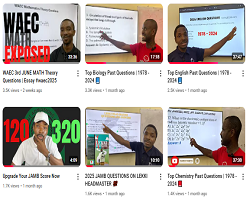Welcome to today’s Chemistry tutorial from AllCBTs, where we simplify science for exam success. Our topic today is “Atoms” — the building blocks of all matter. If you’re preparing for NECO, WAEC, or JAMB 2025, this lesson is a must-read!
You can watch the full class in the video below:
What are Atoms?
Atoms are the smallest indivisible particles of an element. They form the basic unit of matter. Everything around us — air, water, ruler, books, your phone — is made up of matter, and the smallest part of matter is called an atom.
Definition of Atom:
An atom is the smallest indivisible particle of an element that cannot be further divided chemically.
Atoms combine to form molecules, and both atoms and molecules are fundamental constituents of matter.
Constituents of an Atom: The Three Subatomic Particles
An atom is made up of three main subatomic particles:
- Proton
- Neutron
- Electron
These sub-particles determine the atom’s behavior, charge, and how it bonds with other atoms.
Structure of the Atom (Atomic Structure)
Atoms are not just random blobs — they have a defined structure:
1. Nucleus (Center of the atom)
- Contains protons and neutrons
- Protons are positively charged
- Neutrons carry no charge (neutral)
2. Electron Shells (Orbitals)
- Surround the nucleus
- Contain negatively charged electrons
- Electrons revolve around the nucleus in specific paths called orbitals
Charges and Masses of Atomic Particles
| Particle | Charge | Mass (Relative) |
|---|---|---|
| Proton | +1 (positive) | 1 unit |
| Electron | -1 (negative) | 1/1840 unit |
| Neutron | 0 (neutral) | 1 unit |
Note:
The number of protons is equal to the number of electrons in a neutral atom. This makes the atom electrically neutral.
Why Protons and Electrons Must Balance
- Protons are positive, electrons are negative.
- In every neutral atom, the number of protons = number of electrons.
- This balance neutralizes the atom and gives it electrical stability.
Example:
If an atom has 6 protons, it must also have 6 electrons.
What About Molecules?
A molecule is a group of atoms chemically bonded together.
- It is the smallest unit of a compound that retains its chemical properties.
- Examples:
- H₂O (water) = 2 Hydrogen atoms + 1 Oxygen atom
- CO₂ = 1 Carbon + 2 Oxygen
Watch more educational videos and past questions: https://youtube.com/@allcbts
Summary
- Atoms are the smallest unit of matter.
- They are made up of protons, neutrons, and electrons.
- Atoms have a central nucleus with orbiting electrons.
- A molecule is a group of atoms bonded together.
- Understanding atomic structure is fundamental in Chemistry and Physics.
Related Videos:
- Understanding Waves and Properties in Physics
- NECO Mathematics 2025 Past Questions
- NABTEB Mathematics May/June Exam Prep
- National Common Entrance Mathematics 2025
- Introduction to Mechanics in Physics
Keywords
#AtomsInChemistry, #NECO2025Chemistry, #WAEC2025Science, #StructureOfAtom, #ChemistryTutorials, #ProtonElectronNeutron, #AtomicStructureExplained, #AllCBTs, #JAMB2025Prep, #MoleculeVsAtom, #ChemistryForBeginners


